What Is Idea Testing : How It Will Save Your Startup
Validate Before You Build: The Founder’s Guide to Smart Startup Decisions
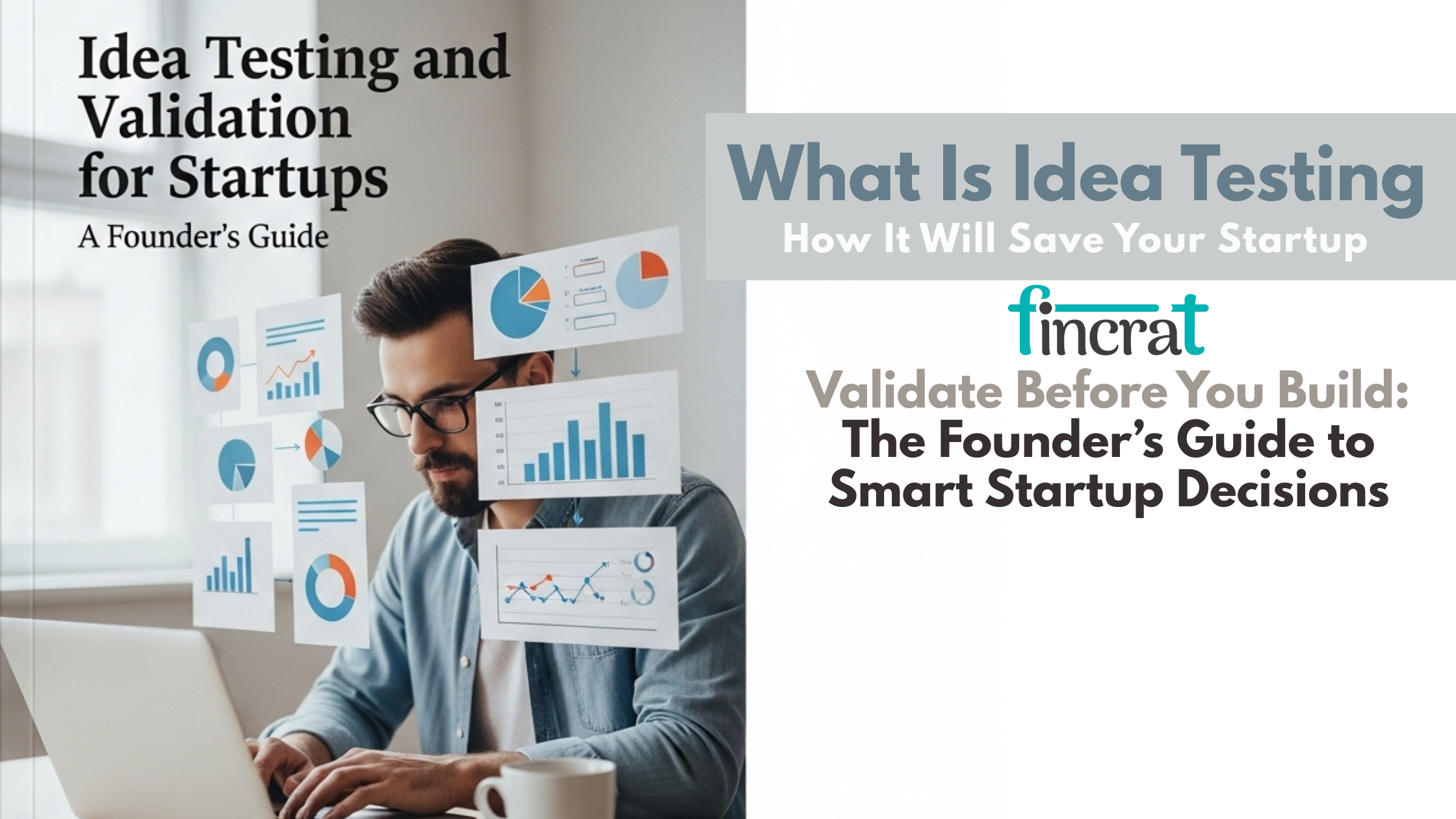
You have a brilliant startup idea — maybe even “the next big thing.” You’re excited, inspired, and ready to build. But hold on. Before you pour your time, money, and energy into development, there’s one critical step you can’t afford to skip:Idea testing.
In a world where 90% of startups fail, most don’t collapse because the product didn’t work — they fail because they built something nobody wanted. Idea testing is the antidote to failure. It helps you find out whether your idea solves a real problem, for real people, who are willing to pay real money.
In this in-depth guide, we’ll break down what idea testing is, why it matters, how to do it, and what tools, frameworks, and examples will help you validate before you build.
What Is Idea Testing?

- Idea testing is the act of evaluating a new product or service idea to determine whether it's feasible and has prospects to succeed in the marketplace.
- It entails looking for input from your intended market, determining market demand, fine-tuning your business model, and enhancing the product or service prior to full-scale development or investment.
- Idea testing generally involves building initial prototypes, conducting A/B tests, and even deploying small-scale pilot programs to test customer interest and iterate the offering.
- The goal is to reduce the risk, enhance the market fit, and make sure important resources are not spent on an idea that may not address customer needs or create demand.
It answers key questions like:
- Does anyone need this?
- Would people pay for it?
- Is the problem painful enough to solve now?
- Are there existing solutions, and how does mine compare?
- Can I build and deliver this cost-effectively?
Idea testing bridges the gap between gut instinct and market reality. It turns assumptions into insights, and insights into smarter decisions.
Why Idea Testing Matters
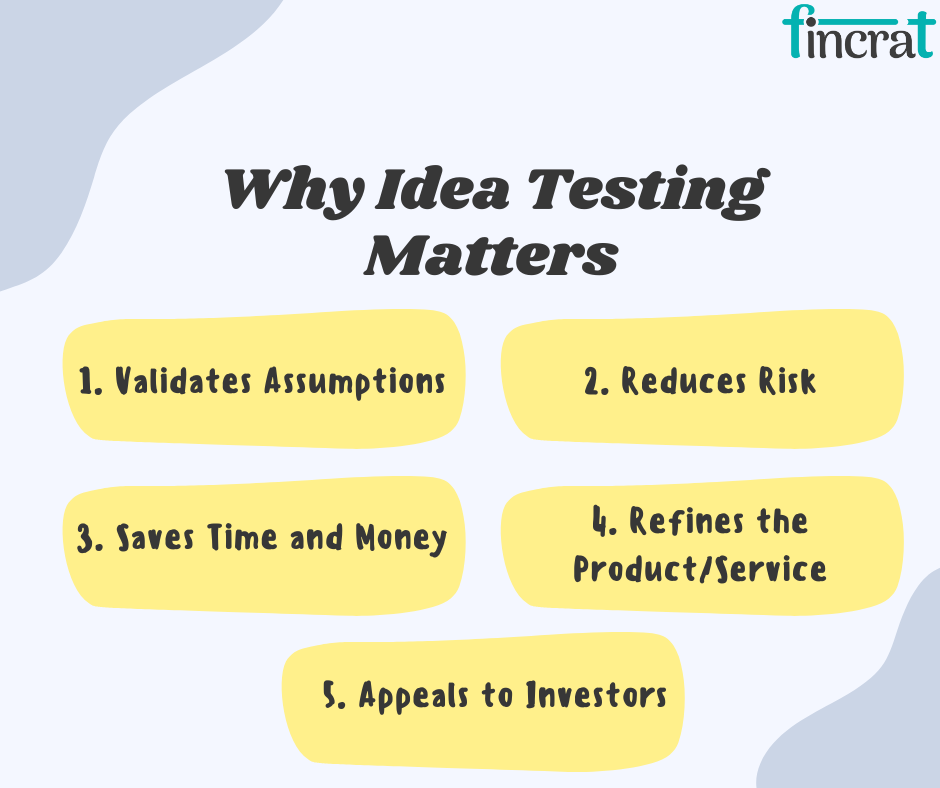
- Validates Assumptions: It allows business owners to validate their assumptions regarding customer needs, the industry, and the business model. If not validated, business owners could be working with faulty assumptions, resulting in wasted resources, money, and time.
- Reduces Risk: Idea testing prior to launch can help spot potential risks and issues, enabling businesses to get rid of them at the outset, minimizing the likelihood of failure.
- Saves Time and Money: Instead of going all-in on a product or business concept, testing enables startups to make tweaks, refine ideas, and switch if needed, saving money spent on a full-blown launch.
- Refines the Product/Service: Ongoing testing results in a deeper comprehension of the product's strengths and weaknesses, allowing refining based on actual customer feedback.
- Appeals to Investors: Investors want tested ideas because they have already proven they can be successful in the market. Testing enables evidence of product-market fit, and therefore, a startup is more likely to raise capital.
Purpose of Idea Testing
The idea test purpose is to validate that a business idea, product, or service is feasible, desirable, and matches market demand prior to committing large amounts of time, money, or resources to development.
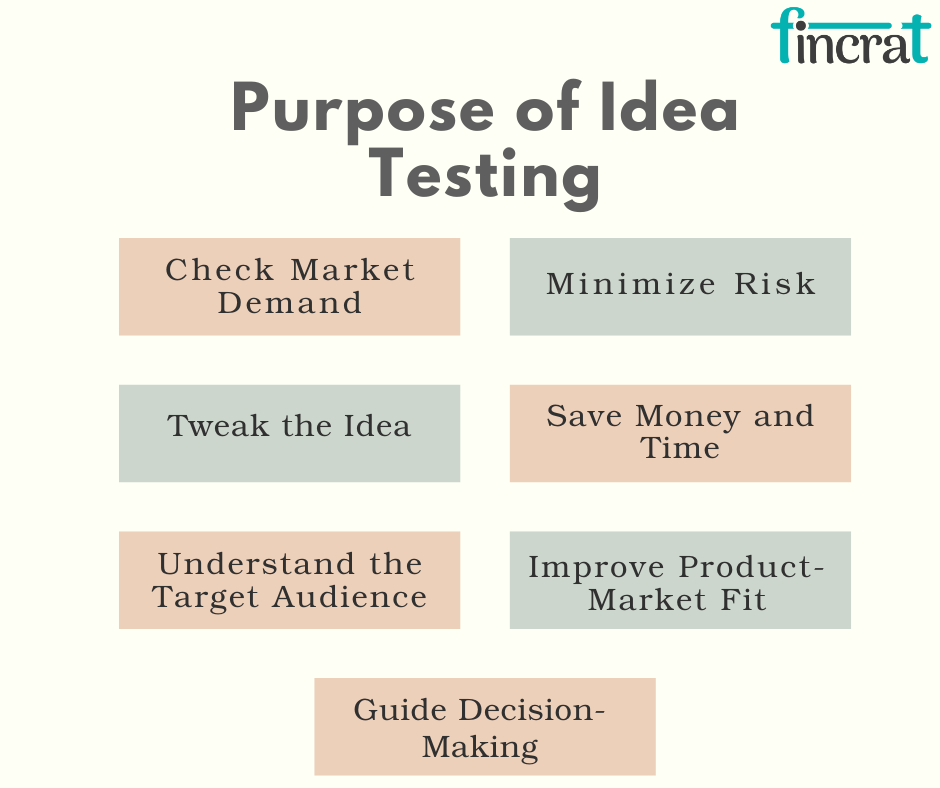
- Check Market Demand: Make sure there's real interest or demand for the concept in your target market.
- Minimize Risk: Spot weaknesses or flaws up front to prevent expensive errors down the road.
- Tweak the Idea: Utilize insights to refine the product, features, or business model prior to launch.
- Save Money and Time: Avoid spending time and money on concepts that will not succeed by prototyping first before mass rollout.
- Understand the Target Audience: Learn about customer behavior, desires, and pain areas.
- Improve Product-Market Fit: Make your idea fit genuine customer needs and market demand.
- Guide Decision-Making: Give facts and evidence to justify whether to move forward, change direction, or drop the idea.
Why Idea Testing Is Crucial for Startups
- Reduces Risk: By testing your idea upfront, you reduce the risk of working on a product that nobody wants or needs.
- Gives Insight: You're getting real insights into customer needs, desires, and pain points that can sharpen your product or service.
- Optimizes Resources: It teaches you how to prioritize where to spend your time, money, and energy in order to get the most impact with the least waste.
- Improves Success Rates: Idea validation makes it more probable that your startup will be a success in the market.
8 Proven Methods for Testing Your Startup Idea
- Customer Interviews
- Surveys and Questionnaires
- Landing Page Testing
- Smoke Tests (Fake Door Testing)
- Prototype Testing (MVPs / Low-Fidelity Prototypes)
- Pre-Sales or Pre-Orders
- Competitor Analysis and Market Research
- Usability Testing
1. Customer Interviews
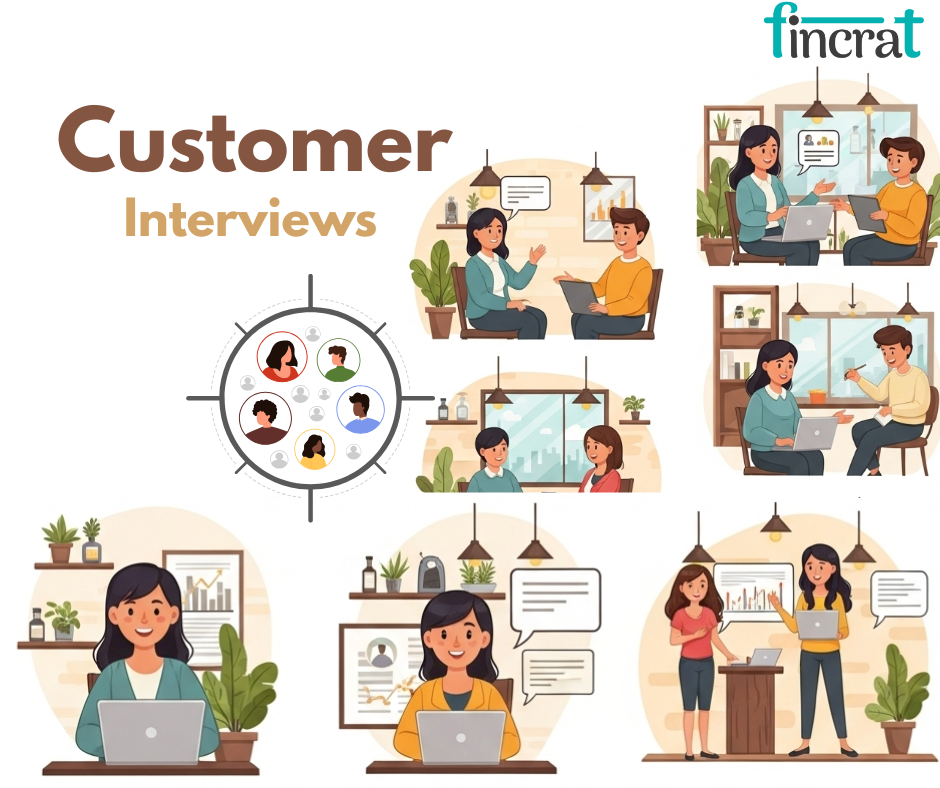
- Customer interviews are direct , qualitative discussions with potential buyers or users to know their needs, behavior, pain areas, and preferences concerning the problem you are attempting to solve.
- Check if the problem actually exists and is important to the customer.
- The problem-solving ways of customers now.
- Assess willingness to pay for a solution.
- 60%-72% of startups that interview at least 15–20 early achieve faster product-market fit.
- Steve Blank's Customer Development approach suggests a minimum of 100 interviews before one makes a complete commitment to a solution.
- Example: A founder creating a mental well-being app interviews 25 working professionals in the 25-40 age group. Most confess using meditation apps but say they are not tailored. This information prompts the founder to concentrate on personalized content creation.
2. Surveys and Questionnaires
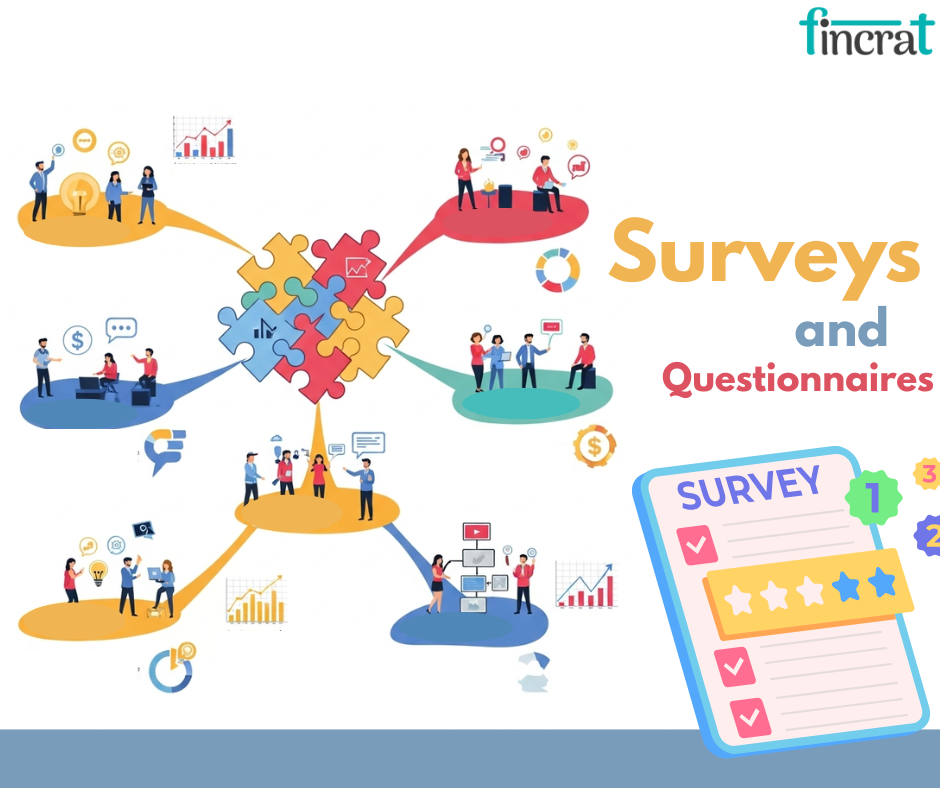
- Formed questionnaires sent to larger audiences to gather quantifiable information regarding customers' opinions, preferences, and habits.
- Gather statistically significant information to back assumptions.
- Scale test demand, price sensitivity, and interest.
- Confirm early hypotheses derived from interviews.
- Survey Monkey discovered that startups applying targeted surveys upfront are 3 times more likely to pivot successfully.
- Greater than 30%-40% response rate for pre-launch surveys is a good indication of interest.
- Example:A founder building a subscription fitness meal delivery service has 500 urban residents complete a Google Form. Findings indicate 68% will pay $9–$12 per meal, and preferred plans are weekly.
3. Landing Page Testing
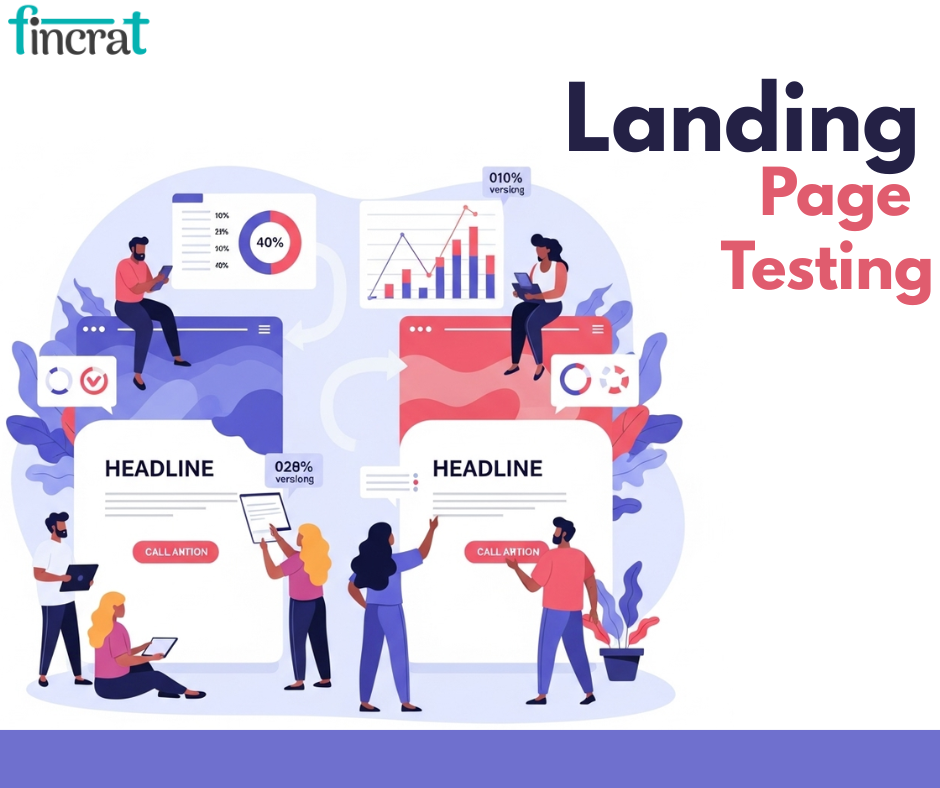
- Developing a minimal website or page that describes the product concept and invites users to perform a certain action (e.g., sign up, join waitlist, pre-order).
- Monitor actual user interest and interaction.
- A/B test value propositions or messaging.
- Capture leads for additional verification.
- Startups with landing pages optimized to convert visitors 40%-50% more than non-optimized startups, according to Unbounce.
- A CTR (click-through rate) of over 2–3% on landing pages is usually viewed as healthy for idea validation.
- Example: An entrepreneur developing a project management application rolls out a landing page with two headlines: Built for Remote Teams and Simple Collaboration for Startups. The latter ranks 2x higher in click-through rate.
4. Smoke Tests (Fake Door Testing)

- A strategy in which a feature or product is promoted as being available (e.g., through ad or button), yet when clicked, tells users it's "coming soon." This tests true interest without creating the product.
- Validate interest prior to building.
- Know what features are most interesting.
- Prioritize development according to user behavior.
- Smoke tests are among the quickest methods to prove demand, particularly for software products.
- As per Y Combinator, smoke tests that are well-executed have the potential to decrease pre-product risk by as much as 60%-70%
- Example: Dropbox famously employed a 3-minute demo video of a fictional product to get thousands of sign-ups, confirming tremendous interest before platform development.
5. Prototype Testing (MVP/Low-Fidelity Prototypes)
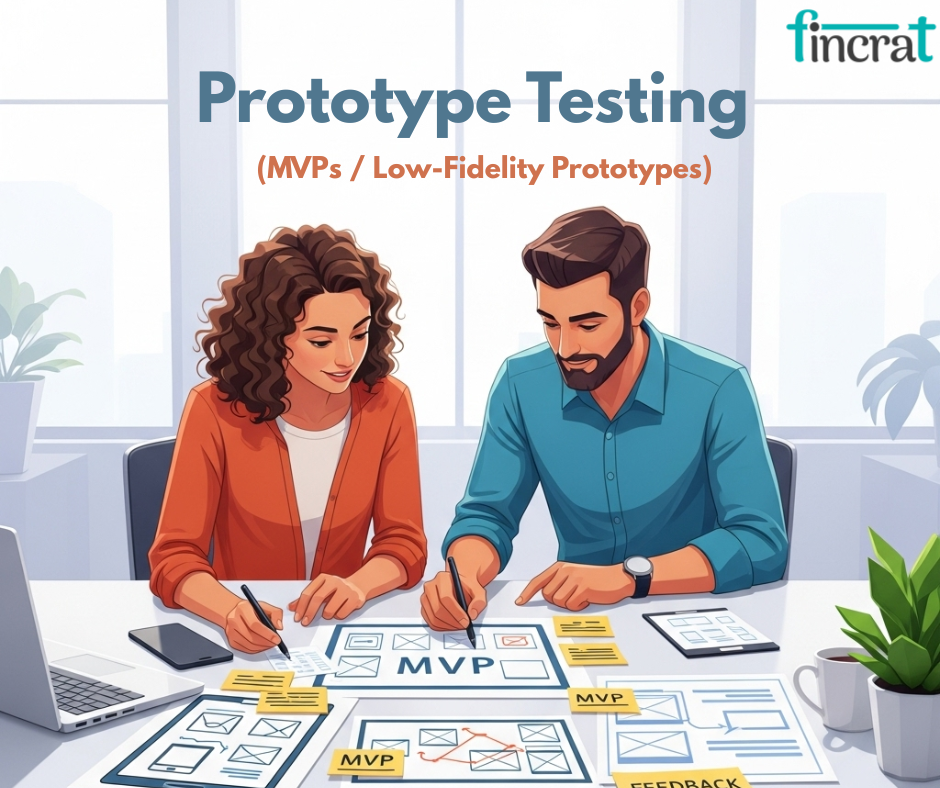
- Developing a bare-bones version of the product—either interactive wireframes or functional MVPs (Minimum Viable Products)—to experiment with real users.
- Gather early feedback on usability and desirability.
- Identify friction or confusion in the user experience.
- Compare actual user behavior with expressed interest.
- Product development costs can be cut by 30–50% for MVP-based startups.
- Airbnb began as a basic MVP—renting air mattresses out during a conference—that eventually became a $100B+ business.
- Example: A founder creates a no-code MVP of a book summary app in Bubble. Users sign up, consume summaries, and provide feedback. The startup finds users want audio summaries, so they pivot to podcast-style delivery.
6. Pre-Sales or Pre-Orders

- Selling your product or taking pre-orders prior to completion to gauge actual willingness to pay.
- Experiment with pricing and demand.
- Ensure that people are not only interested, but also willing to spend money.
- Make early revenue.
- Kickstarter statistics reveal that only 36%-40% of campaigns are successful, indicating just how accurately pre-sales reflect market demand.
- Pre-orders can lower the risk of financial loss and show traction with investors.
- Example: Pebble raised more than $10 million on Kickstarter by revealing a prototype and allowing early bird discounts—when the product was not yet mass-produced.
7. Competitor Analysis and Market Research

- Research of current players in the market in order to discern customer expectations, gaps, and business models.
- Find underserved niches.
- Assess market saturation or potential.
- Do not reinvent the wheel.
- CB Insights cites ignoring the competition as a leading cause of why 19%- 20% of startups fail.
- Good competitor research can enhance positioning and differentiation of the product by 30%-40%.
- Example:An entrepreneur in fintech finds out that there are many personal budget apps, but none of them support regional languages in India. This realization inspires developing a multilingual financial literacy app.
8. Usability Testing
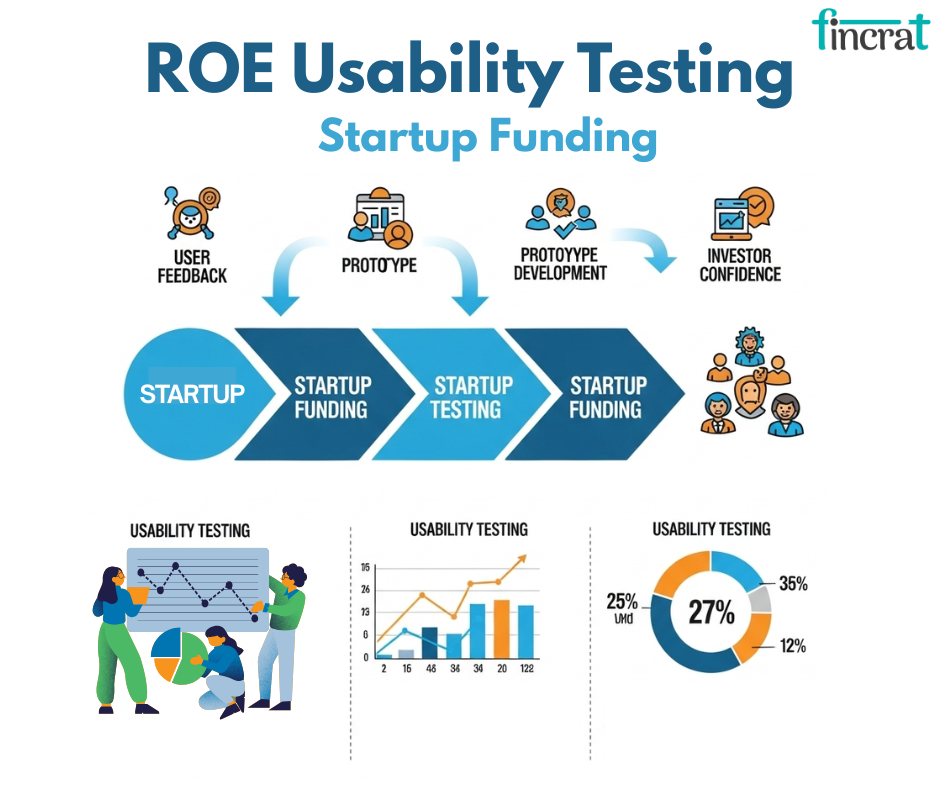
- Watching users while they are using a product to spot areas of usability concern and for improvement.
- To get feedback on whether the product is intuitive and user-expectation-friendly.
- Usability testing can reveal matters that developers might miss.
- It is important for improving user satisfaction and uptake of the product.
- Example:A software firm observes users going through their new app to find out frustrating interfaces or features.
When Should You Test Your Idea?
Testing your idea is crucial at various stages of your startup journey. However, determining the right time to test can make a huge difference in ensuring that your efforts are focused and productive.
1. Before You Build Anything (Pre-Development Phase)
- One way to test your idea first is to check if it attracts the interest of your target audience before investing much in development.
- You can prevent spending resources on an idea that does not enjoy strong demand or market interest.
- Methods:You can make use of methods such as customer interviews, surveys, and landing page testing in order to gather feedback before any major investment.
2. After Building a Minimum Viable Product (MVP)
- After you have a minimal version of your product (MVP), you can start testing whether or not your target users will actually use it.
- You can test at this point to measure real-life usage, understand pain points, and verify core functionality.
- Methods:Prototype testing, usability tests, or pre-sales are typical methods at this point.
3. Pre- Launch on Full Scale
- Testing prior to a public release assists in the discovery of issues and confirms that you possess a solid product-market fit.
- You don't desire to start a product with important bugs or functionalities that aren't connecting with users.
- Methods:You may utilize beta testing, soft launches, or paid advertisement campaigns to attain first-hand feedback and implement needed changes.
4. After Iterations or Changes
- After updating or introducing new features in your product, testing ensures that you know whether the updates function as you expect.
- Ongoing testing guarantees that you are constantly refining your product through customer feedback and market demands.
- Methods: Do follow-up usability testing and A/B testing to enhance the user experience.
5. When You Plan to Scale
- When it is time to scale your business, testing assists in determining whether your business model has the potential to scale and whether the demand is sustainable.
- Testing at this level ensures that your marketing efforts, customer acquisition strategies, and operations are scalable.
- Methods: Employ financial projections, growth indicators, and customer surveys to confirm your scalability potential.
6. When You Want to Confirm Product-Market Fit
- Testing ensures that your product actually solves a meaningful market problem and that people are actually willing to pay for it.
- Product-market fit is essential for long-term success, and testing provides you with clarity about whether or not you are heading in the right direction.
- Methods:Engage in pre-orders, interviews with customers, and feedback loops to quantify the degree of product-market fit.
How Idea Testing Will Save Your Startup
Idea testing is like a startup’s immune system. It helps detect threats, prevent fatal mistakes, and strengthen your ability to grow intelligently.
Here’s how it can literally save your business:
1. Avoids Wasted Time and Money
- Startups fail after spending months (or years) developing products no one cares about.
- Idea validation prevents you from spending time building a solution to an unimportant problem or creating features no one will care about.
2. Reveals Market Demand Early
- It's preferable to learn about lack of demand ahead of launch.
- Testing shows if there is genuine hunger for your concept — or polite interest only.
3. Reduces What to Build (and What to Omit)
- Rather than speculating what features users require, testing prioritizes precisely what they care about.
- You don't end up overbuilding or investing in the wrong roadmap.
4. Enhances Your Pitch to Investors
- Investors don't invest in ideas — they invest in validated demand.
- Demonstrating traction, sign-ups, or customer conversations gives you bargaining power and authority.
5. Increases Founder Confidence
- With feedback and data in hand, you know your next step.
- You're not trusting your gut alone — you're informed by evidence.
6. Avoids Emotional Attachment to Bad Ideas
- Testing compels you to confront facts in advance.
- It distinguishes cool ideas from real business possibilities.
7. Turns Your Early Customers into Evangelists
- When individuals are brought on board early in forming the concept, they are emotionally attached.
- They provide improved feedback, refer to other people, and become champions.
Step-by-Step Guide to Creating Idea Testing
Testing your startup idea is a critical part of the early-phase development process.
1. Define Your Hypothesis
- Begin by writing down the assumptions that you're trying to test. This is really a hypothesis regarding your product or market.
- Determine the issue you're addressing, your target market, and your solution. Put it in the form of a statement that can be tested.
- Example: My target market, small business owners, will pay for a subscription-based project management tool that they can use with Google Drive.
2. Select the Proper Testing Method
- Choose the testing methods that fit at your business stage and the hypothesis you wish to test.
- There are a few kinds of tests qualitative and quantitative—so have a think about which methods suit your circumstances.
- Qualitative: Customer interviews, questionnaires, testing of prototypes.
- Quantitative: A/B testing, questionnaires with measurable results.
- Example:At the early stages of the process, customer interviews or testing of landing pages might be suitable. For more developed products, ad or pre-sales testing can be useful.
3. Create a Minimum Viable Product (MVP)
- Create a minimal version of your product to try out.
- The MVP should only include the essential features to validate your hypothesis.
- Don't strive for perfection; rather, test the basic things of your concept.
- It may be a prototype, a stripped-down service offer, or even a landing page.
- Example: If you're testing a food ordering app, build a simple web page describing the idea, with a sign-up form to elicit interest.
4. Know Your Target Audience
- Be clear about who you're testing with so that feedback is relevant and useful.
- Refine your target customer group based on the market segment you're targeting. This is important for obtaining useful insights.
- Example:If you were to test a new fitness app, your target audience might be young adults aged 25-40 in cities.
5. Carry out the Test
- Carry out the testing process among the target audience.
- Depending on the method you've selected, you may administer:
- Surveys/Questionnaires: Distribute to your target audience to gather their feedback.
- Customer Interviews: Engage directly with your potential customers and get their insights into what problems they face and what they need.
- Prototype Testing: Let users touch and play around with a mock-up or functional version of the product.
- Example: Create an online survey in which users score their interest in the idea, or perform a customer interview to determine whether they see value in your product idea.
6. Evaluate the Feedback
- Take a careful look at the answers and feedback from your test to figure out what worked and what didn't.
- Collect both qualitative and quantitative information from your tests and seek patterns.
- What are the common pain points? What are the potential customers excited about?
- Example: If your test for the landing page indicates a great sign-up rate, but users do not take further actions, there could be an issue with the offer and customer expectation mismatch.
7. Iterate Based on Results
- Adjust your idea and approach based on the feedback collected.
- Use test data to make strategic adjustments. Refine your concept, adjust your messaging, features, or target audience, and retest as needed.
- Example: If customers are not enthusiastic about your app's user interface, try redesigning the user experience and testing again before implementing more features.
8. Validate or Pivot
- Determine whether to proceed with the current version of your concept or pivot completely based on the test results.
- If testing indicates robust demand and customer interest, proceed with development.
- If the feedback indicates major flaws, pivot or adjust your strategy.
- Example: if after testing, customers express interest but request extra features (e.g., integrations), you can pivot your product to supply that demand.
9. Track the Long-Term Effect
- Determine whether the validated idea has the potential to create long-term growth.
- Once your product has been validated and you’re seeing positive response from customers, track long-term metrics, like retention rates, customer lifetime value, and monthly active users.
- Example:Track how often customers use your app, whether they share it with others, and if they continue subscribing after the first month.
10. Test Again (Optional)
- Testing should be an ongoing process. As your product evolves, new assumptions will need to be tested.
- Just keep reiterating, improving, and testing along the way as you scale. New features, product lines, and marketing tactics should always be tried out on your target market.
- Example: If you introduce a new feature in your application, try testing it through customer feedback or by implementing A/B testing.
10 Smart Questions to Ask During Idea Testing
- What problem are you currently facing with [topic]?
- How are you solving this today?
- What’s frustrating about the current solution?
- How often does this problem occur?
- Would you pay to solve this problem? Why or why not?
- How much would you expect to pay for a solution?
- What would make you switch to a new product?
- What would make you not use a solution like this?
- How critical is this problem in your life or work?
- Would you be willing to try a beta version?
Final Thoughts:Great Startups Begin with Great Testing
Idea testing isn’t a luxury — it’s a survival strategy for every serious founder. In a world where resources are limited and competition is fierce, testing your idea before building can save you thousands in time, money, and effort.
More importantly, it ensures you’re creating something your users actually need and are willing to pay for. It’s the difference between launching with confidence or guessing in the dark.
Idea testing gives you clarity, direction, and control — qualities that are essential in the unpredictable early days of a startup. Real startups aren’t born from assumptions; they’re born from understanding.
In today’s fast-paced market, speed still matters — but testing first is what truly sets winning founders apart.

